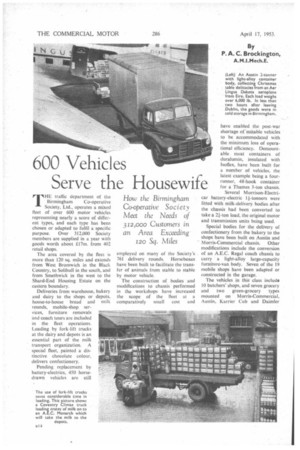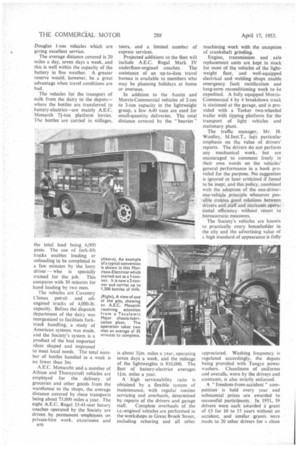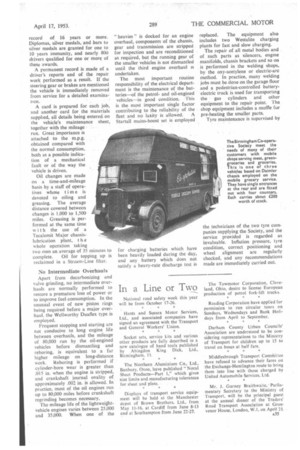600 Vehicles
Page 48

Page 49

Page 50

Page 53

If you've noticed an error in this article please click here to report it so we can fix it.
Serve the Housewife By P. A. C. Brockington,
A.M.I.Mech.E.
How the Birmingham Co-operative Society Meet the Needs of 312,000 Customers in an Area Exceeding 120 Sq. Miles THE traffic department of the
Birmingham Co-operative Society, Ltd., operates a mixed fleet of over 600 motor vehicles representing nearly a score of different types, and each type has been chosen or adapted to fulfil a specific purpose. Over • 312,000 Society members are supplied in a year with goods worth about f17m. from 402 retail shops.
The area covered by the fleet is more than 120 sq. miles and extends from West Bromwich in the Black Country, to Solihull in the south, and from Smethwick in the west to the Shard-End Housing Estate on the eastern boundary.
Deliveries from warehouse, bakery and dairy to the shops or depots, house-to-house bread and milk rounds, mobile-shop services, furniture removals and coach tours are included in the fleet operations. Loading by fork-lift trucks at the dairy and depots is an essential part of the milk transport organization. A special fleet, painted a distinctive chocolate colour, delivers confectionery.
Pending replacement by battery-electrics, 450 horsedrawn vehicles are still employed on many of the Society's 761 delivery rounds. Horseboxes have been built to facilitate the transfer of animals from stable to stable by motor vehicle.
The construction of bodies and modifications to chassis performed in the workshops have increased the scope of the fleet at a comparatively small cost and have enabled the post-war shortage of -suitable vehicles to be accommodated with the minimum loss of operational efficiency. Demountable meat containers of duralumin, insulated with Isoflex, have been built for a number of vehicles, the latest example being a fourrunner, 48-hook container for a Thames 3-ton chassis.
Several Morrison-Electricar battery-electric li-tonners were fitted with milk-delivery bodies after the chassis had been converted to take a 21-ton load, the original motor and transmission units being used.
Special bodies for the delivery of confectionery from the bakery to the shops have been built on Austin and Morris-Commercial chassis. Other modifications include the conversion of an A.E.C. Regal coach chassis to carry a light-alloy large-capacity furniture-van body. Seven of the 19 mobile shops have been adapted or constructed in the garage.
The vehicles in this class include 10 butchers' shops, and seven grocery and two green-grocery types mounted on Morris-Commercial, Austin, Karrier Cub and Daimler chassis, the last-named being a bus chassis with a fluid coupling and Wilson gearbox.
Three grocery shops mounted on Daimler chassis, have single entrances at the rear and four counters. Stock valued at £200 is carried, and from Monday to Friday goods worth about £550 are normally sold on the housing estates. Two servers are in attendance on weekdays and four at the week-ends.
The travelling shops selling greengroceries are mounted on MorrisCommercial 2i-ton chassis and goods are served from both sides and at the back by the driver and a boy assistant. On weekdays the takings average about £5 an hour, and on Saturdays they increase to more than £7 an hour. The rate at which purchases are made depends upon the willingness of the customers to buy direct from the vehicle; in some districts the householders expect deliveries to be made at their doors and this takes up valuable time.
An example of a typical milkdelivery round on a housing estate is provided by the converted Morrison-Electricar 2-ton batteryelectric from which 1,500 bottles are delivered, and to which an equal number of empties are returned, in five hours. Although the Society is constantly experimenting with other vehicle types, the battery-electric is considered to be the only economic substitute for the horse-drawn vehicle.
Horse sense, in the precise interpretation of the term, is of great value to the roundsman, and during the delivery part of a run the horse's intimate knowledge of the power units responsibilities cannot be matched by the most tractable manmade mechanism. The animal's inability to keep pace with other traffic on the outward and return journeys is, however, a decisive disadvantage.
On house-to-house deliveries of coal, the horse-drawn vehicles are being replaced by Austin and MorrisCommercial petrol-engined lorries with a 60-bag capacity, operating from eight depots each located in the area covered.
Bread and laundry deliveries are also made by battery-electric vehicles, 270 of which are engaged on 450 rounds. The vehicles are based on 10 decentralized depots converted from stables where the batteries are charged and all routine maintenance work performed. The fleet mainly comprises Austin-Crompton-Parkinson 1-tonners and 30-cwt. vans, and Douglas 1-ton vehicles which are giving excellent service.
The average distance covered is 20 miles a day, seven days a week, and this is well within the capacity of the battery in fine weather. A greater reserve would, however, be a great advantage when travel conditions are bad.
The vehicles for the transport of milk from the dairy to the depots— where the bottles are transferred to battery-electrics—are mainly A.E.C. Monarch 71-ton platform lorries. The bottles are carried in stillages.
the total load being 6,000 pints. The use of fork-lift trucks enables loading or unloading to be completed in a few minutes by the lorry driver — who is specially trained for the job. This compares with 30 minutes for hand loading by two men.
The vehicles are Coventry Climax petroland oilengined trucks of 4,000-lb. capacity. Before the dispatch department of the dairy was reorganized to facilitate forktruck handling, a study of American systems was made, and the Society's system is a product of the best imported ideas shaped and improved to meet local needs. The total number of bottles handled in a week is no fewer than 3m.
A.E.C. Monarchs and a number of Albion and Thornycroft vehicles arc employed for the delivery of groceries and other goods from the warehouse to the shops, the average distance covered by these transports being about 75,000 miles a year. The eight A.E.C. Regal 33-41-seat luxury coaches operated by the Society are driven by permanent employees on private-hire work, excursions and B16 tours, and a limited number of express services.
Projected additions to the fleet will include A.E.C. Regal Mark IV underfloor-engined coaches. The assistance of an up-to-date travel bureau is available to members who may be planning holidays at home or overseas.
In addition to the Austin and Morris-Commercial vehicles of 2-ton to 3-ton capacity in the lightweight group, a few A40 vans are used for small-quantity deliveries. The total distance covered by the " heavies " is about 31m. miles a year, operating seven days a week, and the mileage of the lightweights is 810,000. The fleet of battery-electrics averages Jim. miles a year.
A high serviceability ratio is obtained by a flexible system of maintenance, with regular routine servicing and overhauls, determined by reports of the drivers and garage
staff. Complete overhauls of the i.c.-engined vehicles are performed in the workshops in Great Brook Street, including reboring and all other
machining work with the exception of crankshaft grinding.
Engine, transmission and axle replacement units are kept in stock for most of the vehicles of the lightweight fleet, and well-equipped electrical and welding shops enable emergency fault rectification and long-term reconditioning work to ke expedited. A fully equipped MorrisCommercial 4 by 4 breakdown truck is stationed at the garage, and is provided with a Tasker two-wheeled trailer with tipping platform for the transport of light vehicles and stationary plant.
The traffic manager, Mr. H. Woolley, M.Inst.T., lays particular emphasis on the value of drivers' reports. The drivers do not perform any mechanical work, but are encouraged to comment freely in their own words on the vehicles' general performance in a book provided for the purpose. No suggestion is ignored or later criticized if found to be inept, and this policy, combined with the adoption of the one-driverone-vehicle principle whenever possible creates good relations between drivers and staff and increases operational efficiency without resort to bureaucratic measures.
The Society's vehicles are known to practically every householder in the city and the advertising value of high standard of appearance is fully appreciated. Washing frequency is regulated accordingly, the depots being provided with Tangye power washers. Cleanliness of uniforms and overalls, worn by the drivers and assistants, is also strictly enforced.
A " freedom-from-accident " competition is held every year and substantial prizes are awarded to successful participants. In 1951, 39 drivers were each 'awarded a grant of £3 for 10 to 15 years without an accident, and similar grants were made to 20 other drivers for i clean rccord of 16 years or more. Diplomas, silver medals, and bars to silver medals are granted for one to 10 years immunity, and nearly 800 drivers qualified for one or more of these awards.
A permanent record is made of a driver's reports and of the repair work performed as a result. If the steering gear or brakes are mentioned the vehicle is immediately removed from service for a detailed examination.
A card is prepared for each job, and another card for the materials supplied, all details being entered on the vehicle's maintenance sheet, together with the mileage run. Great importance is attached to the m.p.g. obtained compared with the normal consumption, both as a possible indication of a mechanical fault or of the way the vehicle is driven.
Oil changes are made on a time-and-mileage basis by a staff of operatives whose time is devoted to oiling and greasing. The average distance covered between changes is 1.000 to 1,500 miles. Greasing is performed at the same time with the use of a Tecalemit Major chassislubrication plant, t h e whole operation taking two men an average of 35 minutes to
complete. Oil for topping up is reclaimed in a Stream-Line filter.
No Intermediate Overhauls
Apart from decarbonizing and valve grinding, no intermediate overhauls are normally performed to restore a premature loss of power or to improve fuel consumption. In the unusual event of new piston rings being required before a major overhaul. the Wellworthy Duaflex type is employed.
Frequent stopping and starting are not conducive to long engine life between overhauls, and the mileage of 80,000 run by the oil-engined vehicles before dismantling and reboring, is equivalent to a far higher mileage on long-distance work. Reboring is performed if cylinder-bore wear is greater than .015 in. when the engine is stripped, and crankshaft journal ovality of approximately .002 in. is allowed. In practice, most of the oil engines run up to 80,000 miles before crankshaft regrinding becomes necessary.
The mileage life of the lightweightvehicle engines varies between 25,000 and 35,000. When one of the " heavies " is docked for an engine overhaul, components of the chassis, gear and transmission are stripped for inspection and are reconditioned as required, but the running gear of the smaller vehicles is not dismantled until the third engine overhaul is undertaken.
The most important routine responsibility of the electrical department is the maintenance of the batteries—of the petroland oil-engined vehicles—in good condition. This is the most important single factor contributing to the reliability of the fleet and no laxity is allowed. A Startall mains-boost set is employed for charging batteries which have been heavily loaded during the day, and any battery which does not satisfy a heavy-rate discharge test is replaced. The equipment also includes two Westalite charging plants for fast and slow charging.
The repair of all metal bodies and of such parts as silencers, engine manifolds, chassis brackets and so on is performed in the welding shops, by the oxy-acetylene or electric-arc method. In practice, many welding jobs must be done on the garage floor and a pedestrian-controlled batteryelectric truck is used for transporting the • gas cylinders and other equipment to the repair point. The shop equipment includes a muffle for pre-heating the smaller parts.
Tyre maintenance is supervised by the technicians of the two tyre companies supplying the Society, and the service provided is regarded as invaluable. Inflation pressure, tyre condition, correct positioning and wheel alignment are regularly checked, and any recommendations made are immediately carried out.




















































































